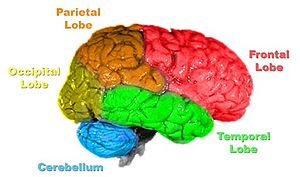Cerebrum facts for kids

The cerebrum is the biggest part of your brain. It's located at the front and top of your head. This amazing part of your brain has about 15 billion tiny cells! It's also the newest part of the brain that has developed over time.
Contents
What Does the Cerebrum Do?
The cerebrum is like your brain's main control center. It takes in information from your sight, hearing, touch, smell, and taste. Then, it helps you understand what you're experiencing.
This important part of your brain also controls your actions. It helps you move your muscles when you want to. The cerebrum is where you do your thinking, planning, and problem-solving. It also helps you speak and organize information. These are often called your 'higher mental functions'.
How is the Cerebrum Built?
The cerebrum is split into two halves. These are called the cerebral hemispheres. Imagine two big halves connected in the middle! These two halves are joined by three strong bands of nerve fibres. These bands help the two sides talk to each other.
Outer and Inner Layers
The outside layers of the cerebrum are made of something called grey matter. This outer layer is known as the cerebral cortex. It's where a lot of the thinking happens.
The inner layers are made of white matter. This white matter is mostly made of nerve fibers that send messages around. You'll also find special groups of cells called the basal ganglia inside.
Special Areas for Different Jobs
Inside the cerebrum, different areas have specific jobs. For example:
- The occipital lobe helps you see. It processes all the visual information your eyes send.
- The temporal lobe helps you hear. It's important for understanding sounds and language.
- The parietal lobe helps you feel touch, temperature, and even smell. It also helps you understand where your body is in space.
- The frontal lobe is like the brain's decision-maker. It plans actions based on what you sense and other important factors.
Images for kids
See also
 In Spanish: Telencéfalo para niños
In Spanish: Telencéfalo para niños





